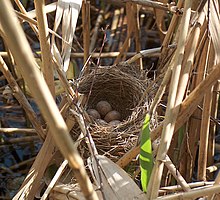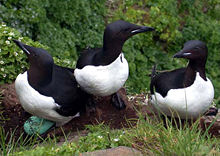From Wikipedia, the free encyclopedia
For animal nests in general, see Nest. For the stadium referred to as "The Bird Nest", see Beijing National Stadium.

Deep cup nest of the Great Reed-warbler
Nests are built each year in most species but some birds refurbish their old nests. The large eyries (or aeries) of some eagles are platform nests that have been used and refurbished for several years.
In yet another extreme, brood parasites have evolved to manipulate and use host individuals either of the same or different species to raise the young of the brood-parasite, which relieves the parasitic parent from the building of nests and the investment of rearing young.
In most species, the female does all or most of the nest construction, though the male often helps.[4] In some polygynous species, however, the male may do most or all of the nest building. The nest may also form a part of their courtship display such as in bowerbirds and weaver birds. The ability to choose and maintain good nest sites and build high quality nests may be selected for by females in these species. In some species the young from previous broods may also act as helpers for the adults.
Contents[hide] |
[edit] Nest types

Thick-billed Murres lay their single eggs directly onto rock ledges.
King and Emperor Penguins also do not build nests; instead, they tuck their eggs and chicks between their feet and folds of skin on their lower bellies. They are thus able to move about while incubating, though in practice only the Emperor Penguin regularly does so. Emperor Penguins breed during the harshest months of the Antarctic winter, and their mobility allows them to form huge huddled masses which help them to withstand the extremely high winds and low temperatures of the season. Without the ability to share body heat (temperatures in the center of tight groups can be as much as 10C above the ambient air temperature), the penguins would expend far more energy trying to stay warm, and breeding attempts would probably fail.[7]
Some crevice-nesting species, including Ashy Storm-petrel, Pigeon Guillemot, Eurasian Eagle-Owl and Hume's Tawny Owl, lay their eggs in the relative shelter of a crevice in the rocks or a gap between boulders, but provide no additional nest material.[8][9] Potoos lay their single egg directly atop a broken stump, or into a shallow depression on a branch—typically where an upward-pointing branch died and fell off, leaving a small scar or knot-hole.[10] Brood parasites, such as the New World cowbirds, the honeyguides, and many of the Old World and Australasian cuckoos, lay their eggs in the active nests of other species.[11][12][13]
No comments:
Post a Comment